
1,000 Stone Steps
One Thousand Stone Steps at the Risshaku-ji Temple Complex
Risshaku-ji, a Tendai sect Buddhist temple,
was founded at Yamadera in 860 CE.
The main hall or konpon-chūdō.,
down close to the river,
houses an eternal flame brought from the Tendai school's
main temple of Enraku-ji on Mount Hiei near Kyōto.
The temple concentrated on the copying of sutras,
Buddhist scriptures.
In 1689 the famous poetry master Matsuo Bashō visited,
and wrote a famous haiku about the setting.
The
previous page
showed the main temple hall and other sights down
near the river.
Now, let's climb the steps to the top!
It's roughly 1,000 stone steps,
sometimes precisely defined as 1,015.
But the steps are rough in places
and you will probably step off to the side to better
see some things along the way,
so your count will vary.
Starting up the Thousand Stone Steps
The bridge over the Tachiya River is at an elevation of about 220 meters, and the temple complex extends up the steep slope to 410 meters. The lane through the lower section of the complex, where the steps start, is about 30 meters higher than the bridge. So, the thousand steps ascend 160 meters.
The path through the lower area passes the main temple hall and forks just past the bell tower. You can pass through a gate there onto the trail and the steps up the mountain. Don't bother counting, signs along the path tell how far you have climbed and how much remains.
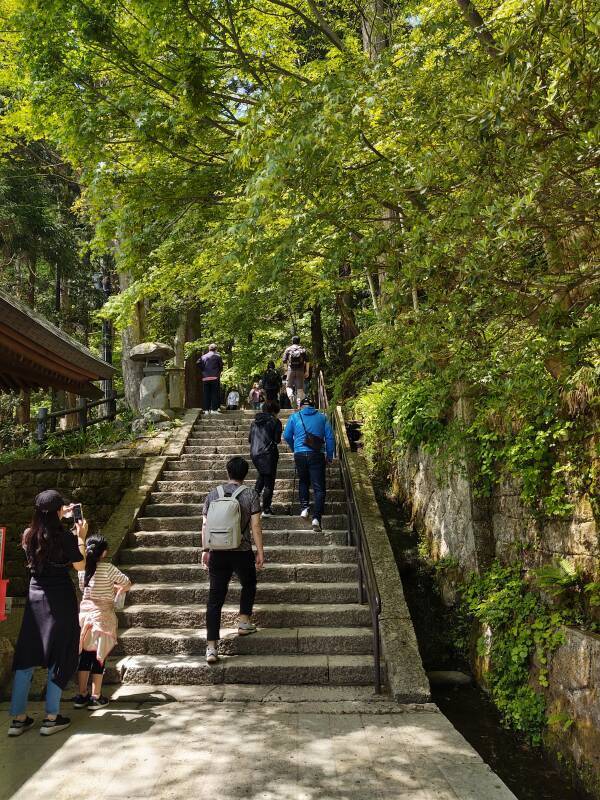

Watch out for monkeys.
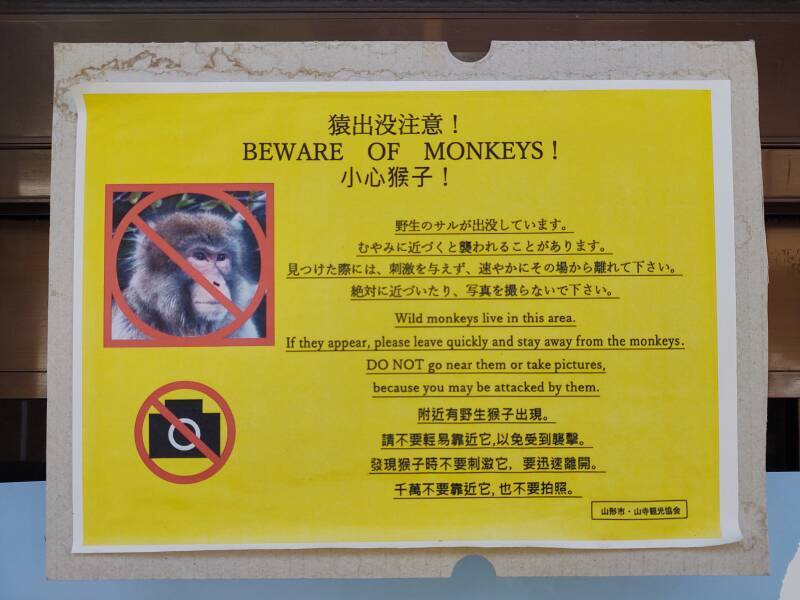
Why does photography especially enrage the monkeys? Are they exasperated by the insistence on winking and peace signs that are de rigueur in Japanese snapshots? Possibly. Have they been harassed by primate paparazzi? Maybe. It's a mystery. But watch out.
Various monuments and small shrines line the path.
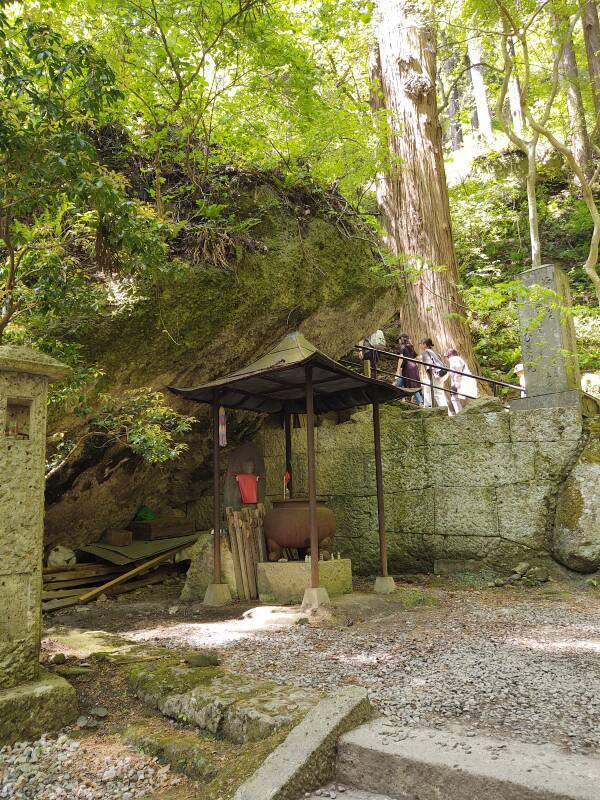

The stairs become very narrow in places. In one place it narrows to four sun, the Japanese version of a traditional Chinese measurement making the path only about 12 cm wide. Of course the narrow spot is named and has its own sign. With people moving in both directions on the path, foot traffic can back up.
The traffic jams got worse when two people had become overwhelmed by the climb. Here came four Yamagata Prefecture fire-fighters helping them down. At least they were still walking, they didn't have to be strapped into stretchers and carried down.
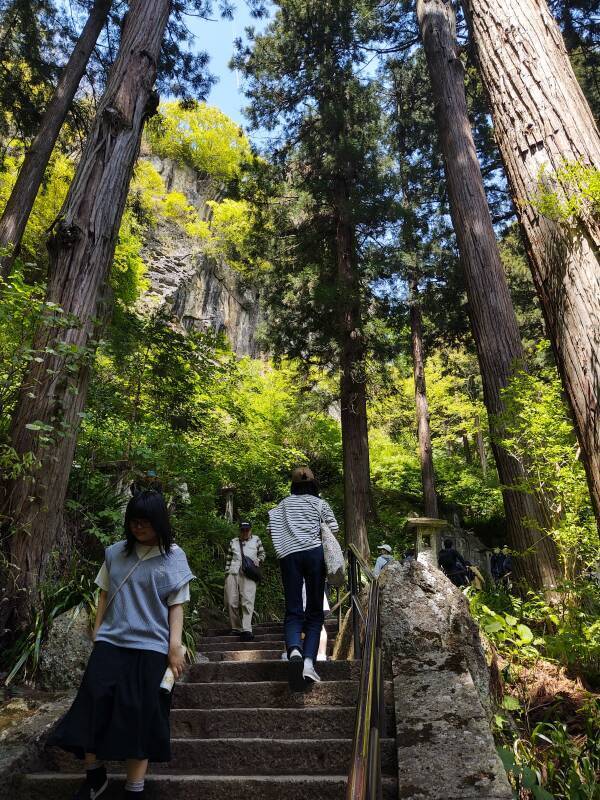
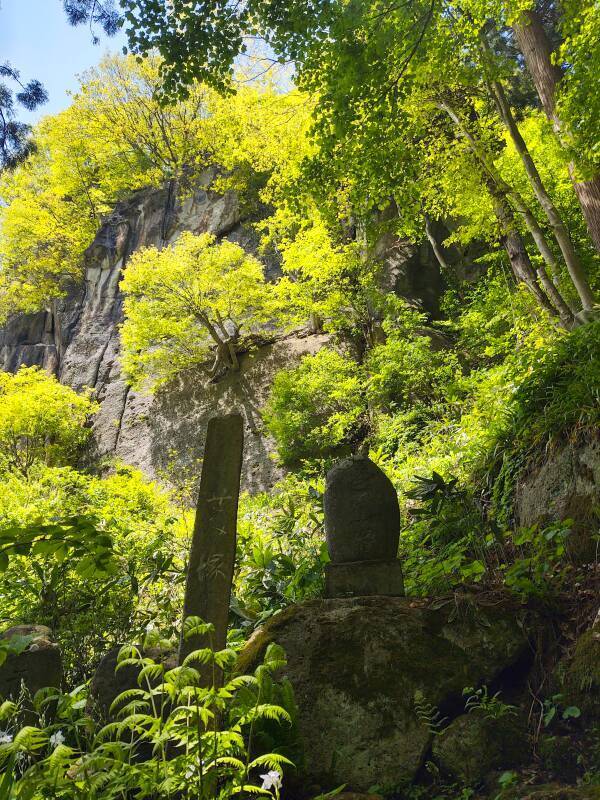
This stone mound and markers are associated with Bashō's 1689 visit to Yamadera, as described on the previous page. This is called Semizuka or the Cicada Mound.
Bashō famously composed a haiku about the sound of the cicadas and the stone cliff faces. Something like:
and the cicada's voice
permeate the rocks
Bashō described the trip and his visit to Yamadera in his book Narrow Road to the Deep North.
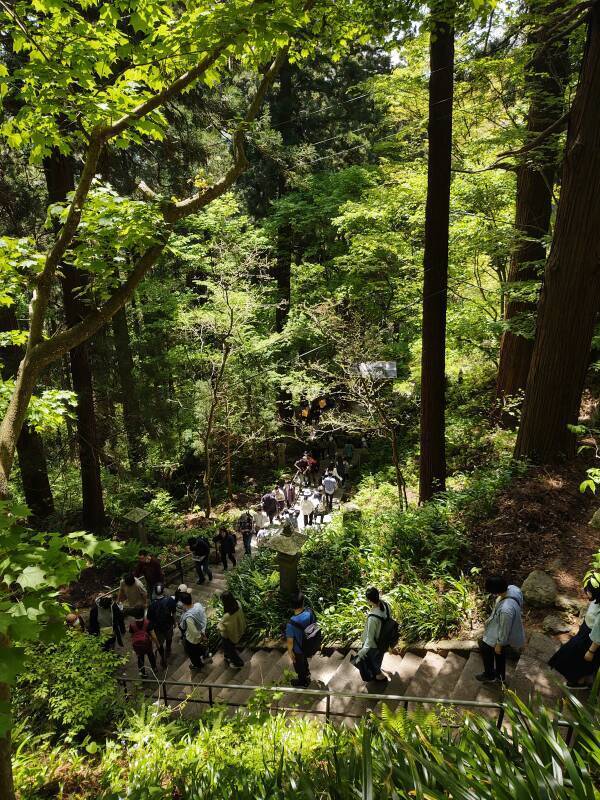
Requested haiku not found.
Try again later.
Almost half-way up, you start to see the Niō-mon gate and other structures in the upper complex. You can step off the trail there at the base of the Mida Hora rock face. It's said to be shaped like a Buddha figure.

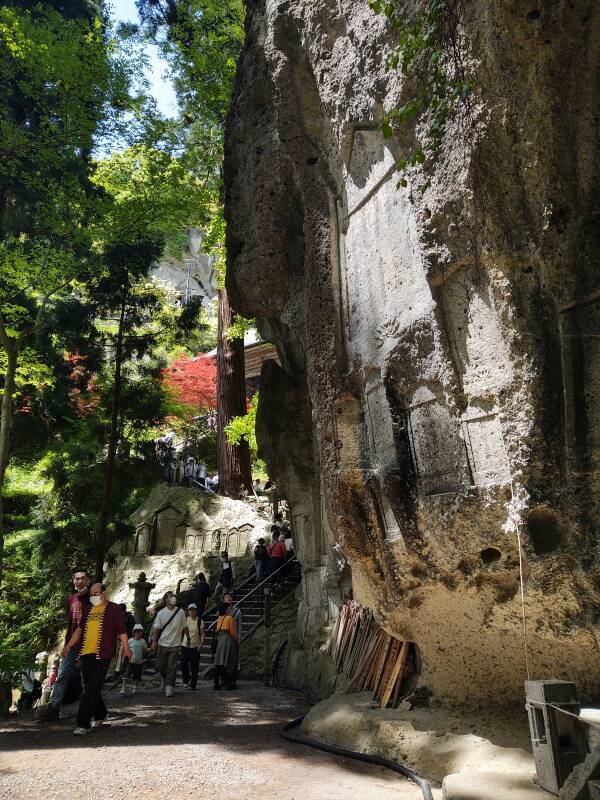
Above and below you see the Mida Hora rock face. The expected hallucination is a five-meter-tall image of Amitābha, known in Japanese as Amida Nyorai, the primary Buddha of Pure Land Buddhism.
Mahāyāna is one of the three main branches of Buddhism, along with Theravāda, the oldest branch, and Vajrayāna, the more tantric or esoteric branch. Pure Land Buddhism, a tradition within Mahāyāna Buddhism, is one of the most widely practiced Buddhist traditions in East Asia.
See the Sukhāvatīvyūha Sūtras for details on the Pure Land of Amitābha.

At lower right in the first picture below, cropped out at right, you see one of the signs reporting your progress along the path.
450 steps up, 550 left to go, Mida Hora is very close to the half-way point.
Scripture passages are carved into the rock face and painted on wooden stakes called sotōba.
The sotōba bear sūtra verses and are divided into five sections like a gorintō or five-level stone pagoda serving as a grave marker or memorial.
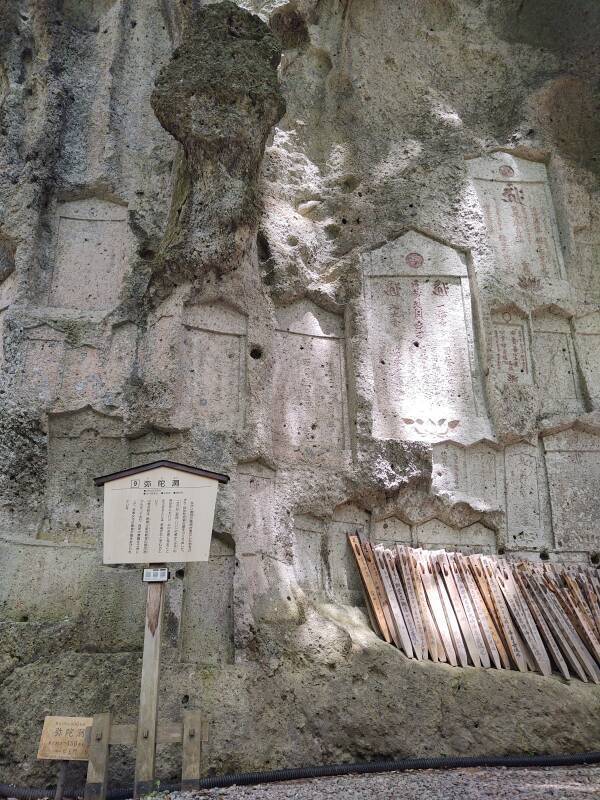
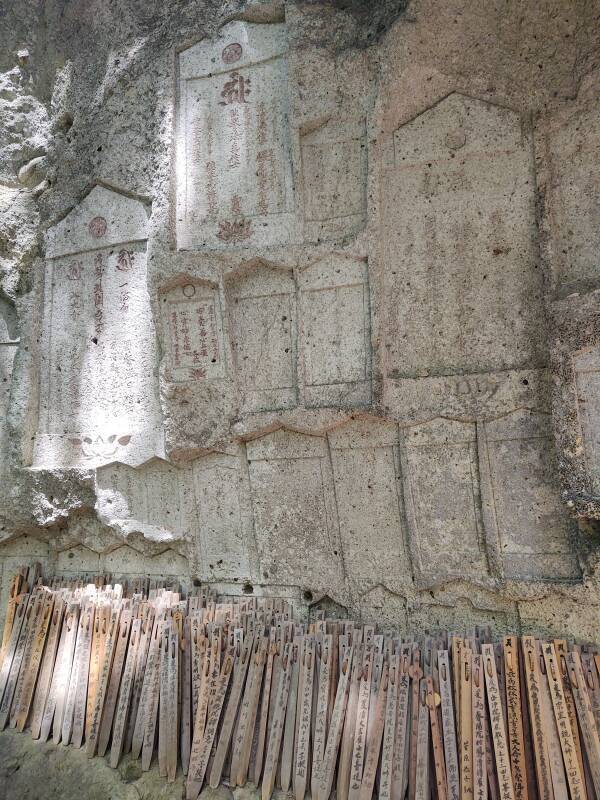
The Niō-mon or "gate with guardians" marks the boundary where you cross into the upper temple area. The gate was built in the 19th century, it's one of the complex's newest buildings.
As usual, statues of Niō guardian figures stand in the alcoves on either side of the gate or mon, preventing the evil-minded from passing through.
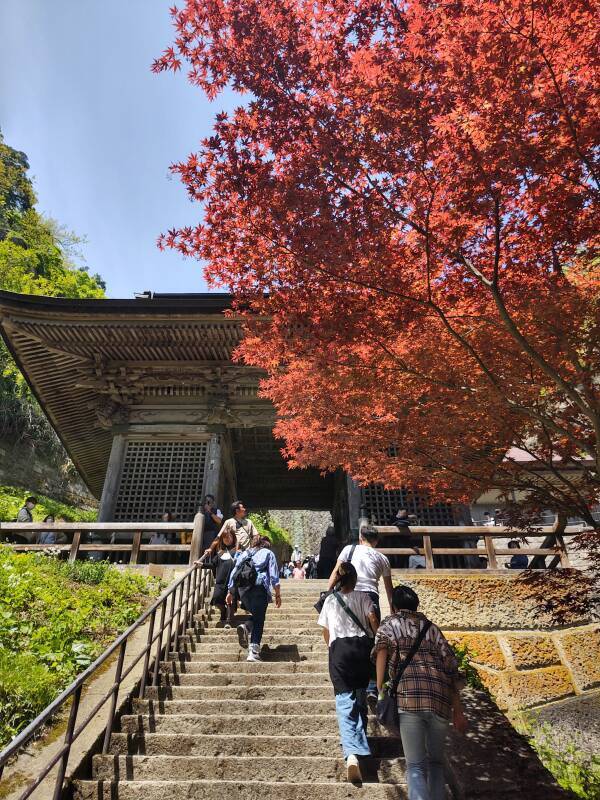
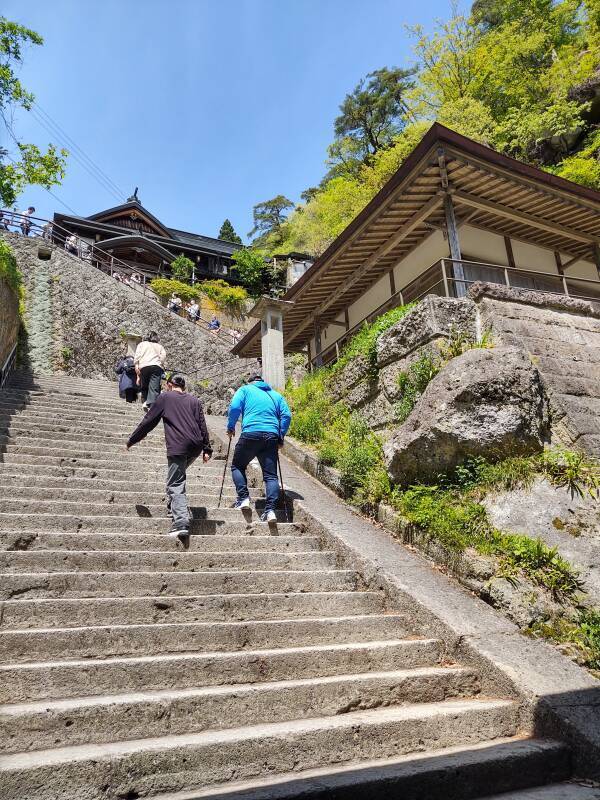


The Risshaku-ji temple complex was founded in 860 CE by the priest Ennin, better known by his posthumous name Jikaku Daishi.
The last picture above and the picture below show the Kaizan-dō hall, where Jikaku Daishi is venerated, and the smaller Nōkyō-dō next to it. In 1948, archaeologists investigated a natural cave beneath the cliff face below the outcropping on which these stand. They found a wooden casket decorated with gold leaf and containing five sets of human remains and fragments of a wooden statue of Daishi, dated to the period around his death. Were his remains included there? Maybe. Some legends say he was buried here, others say that he was buried on Mount Hiei, at the main temple of Enraku-ji Kyōto. A compromise legend says that his head was in the casket at Yamadera while his torso was buried on Mount Hiei.
Daishi is enshrined in Kaizan-dō. Food and incense are offered daily at breakfast and dinner. The hall is normally closed to the public, but every year on January 14th, the anniversary of Daishi's death, the hall is opened and a memorial service is held.
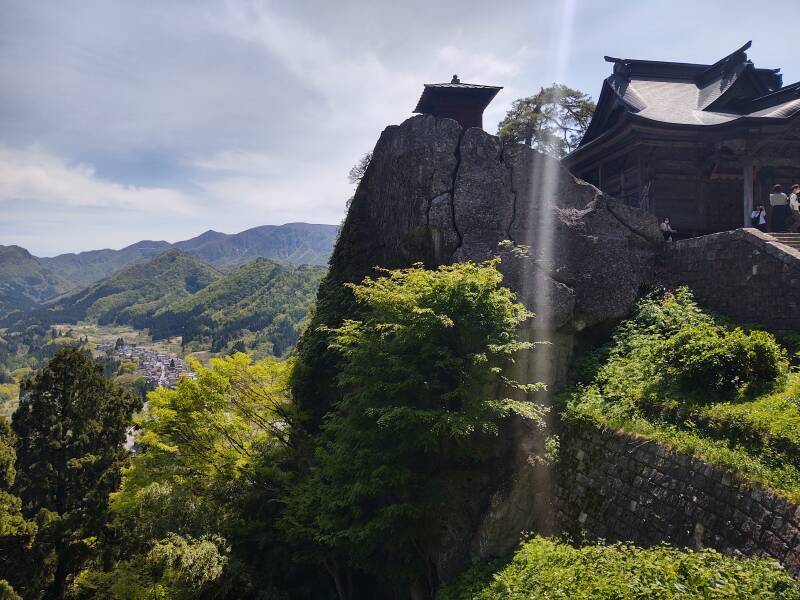
Nōkyō-dō is the oldest building in the temple complex, built to enshrine the hand-copied Lotus Sūtra.
I continued up the remaining steps when I first arrived near the top.
Okunoin or Nyoho-dō temple is at the top of the steps. It has been used for copying the Lotus Sūtra. It's still done in the way prescribed by Jikaku Daishi, writing on hemp paper using graphite-based black ink and a brush made of grass and twigs. The process of completing a copy by hand requires about four years.
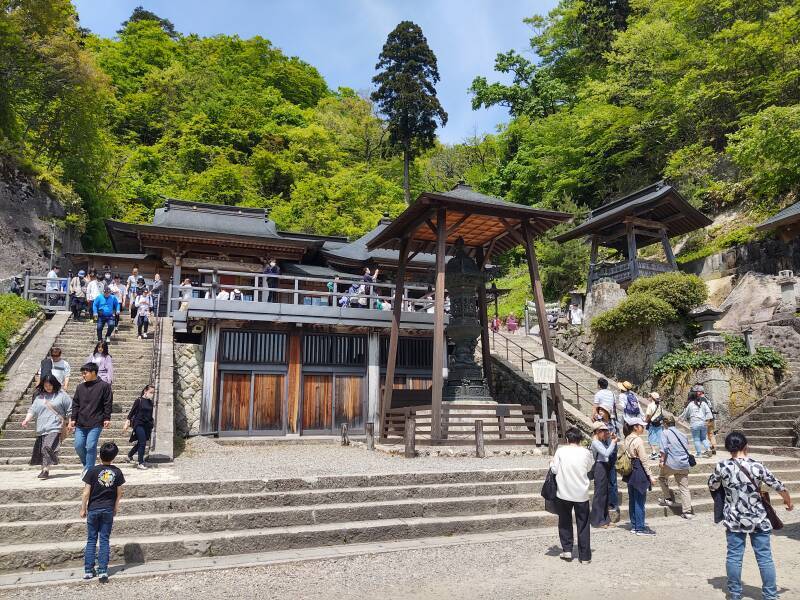
Saddharma Puṇḍarīka Sūtram or the Lotus Sūtra is one of the most influential Mahāyāna sūtras, and one of the best known of all Buddhist scriptures.
It has two central teachings. The first is the doctrine of Ekayāna or the One Vehicle, by which all Buddhist paths and practices can lead to Buddhahood. The second is that the Buddha's lifespan is immeasurable, and so he did not really pass into final nirvana but is still actively teaching the Dharma. That's a philosophical argument adjacent to degrees of infinity and the aleph numbers, ∞ and ℵ0, and so the Buddha is the Buddha but also a bodhisattva.
That's Okunoin at right.
At left is the Daibutsu-den hall with a five-meter statue of Amida Nyorai or Amitābha, the primary Buddha of Pure Land Buddhism.
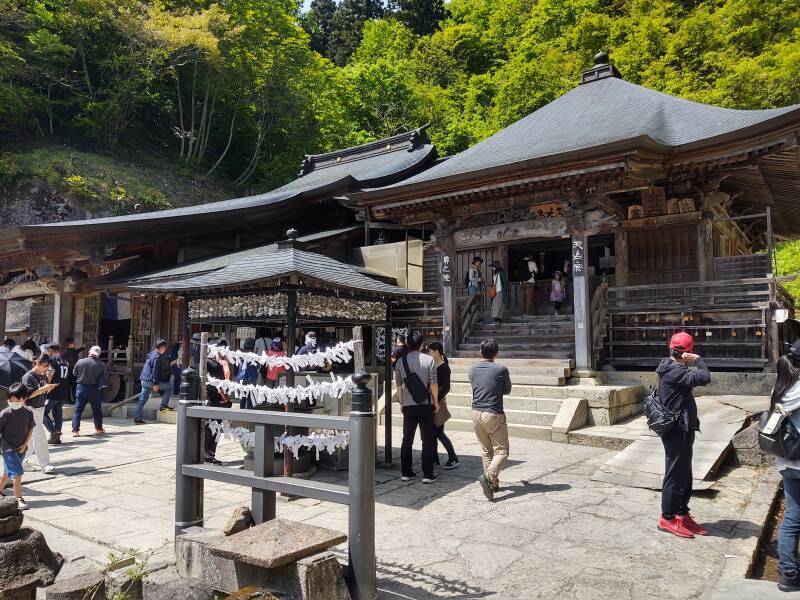
Kōya-san
The Tendai school of Buddhism bases ordination on the Bodhisattva Precepts. That's a set of moral teachings above and beyond the usual monastic rules, laid out in the Brahmajāla Sūtra. Tendai also emphasizes the Esoteric Buddhist teachings brought back from China in the ninth century CE by Kūkai, who founded the Kōya-san mountaintop temple complex, and Ennin, who founded this temple complex.
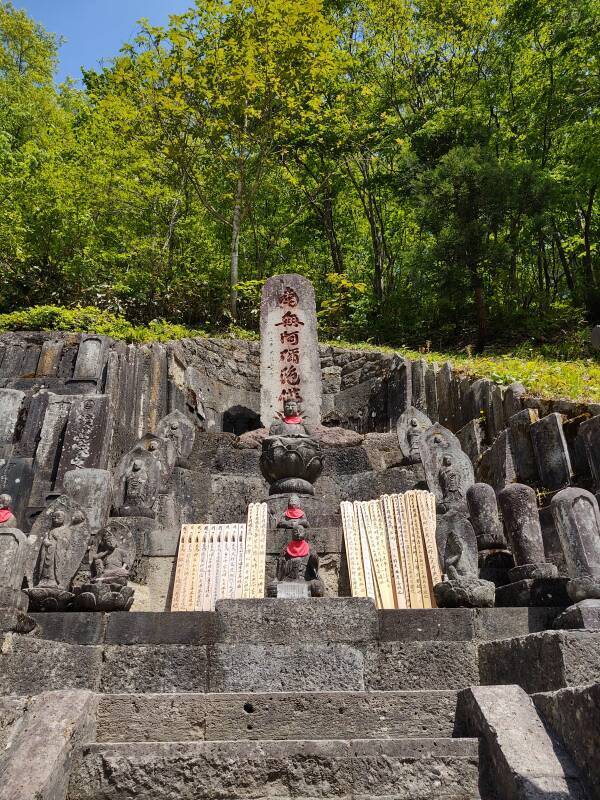
Continuing toward the Kaizan-dō and Nōkyō-dō you come to the famous and old, but quite small, Sanjushoto three-level pagoda. Almost 2.5 meters tall, the pagoda was built in 1519. It's inside a chamber carved out of an unusually shaped rock, behind a glass door and wooden lattice. Notice the small gorintō or multi-element memorials in the pocket within the top of the rock.
Yes, corporations such as Hitachi support restoration and conservation of sacred sites. It's sort of like signs in Italy saying "The Vatican, brought to you by Fiat."

Continuing toward Kaizan-dō and Nōkyō-dō...
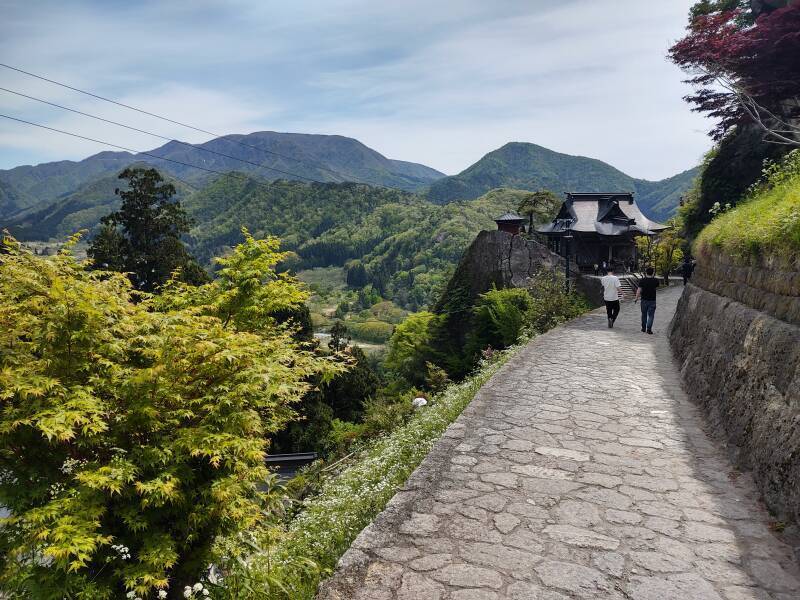
There are fantastic views over the upper temple complex.
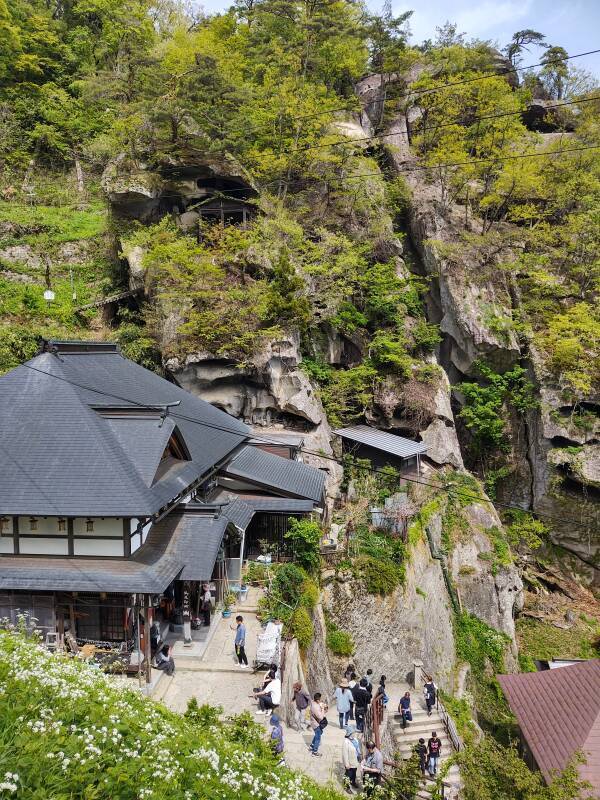

An area near Kaizan-dō and Nōkyō-dō has several memorial markers. Some are rectangular steles with passages written on them. Others represent a person, often bibbed.

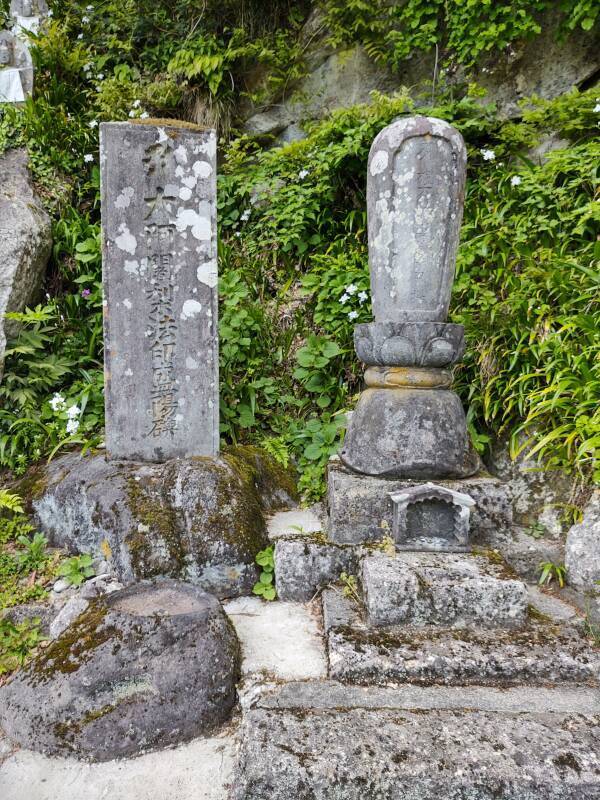

You pass in front of Kaizan-dō as the path narrows and you squeeze between large rocks. Then ascend a little further to the Godai-dō, a temple hall that's actually an observation deck. A version of the Godai-dō was built in 890, although what you see today was built in 1714.
The Godai-dō is well above the Kaizan-dō hall and the Nōkyō-dō sūtra respository. You're looking down over their roofs and out into the valley extending east into the mountains.
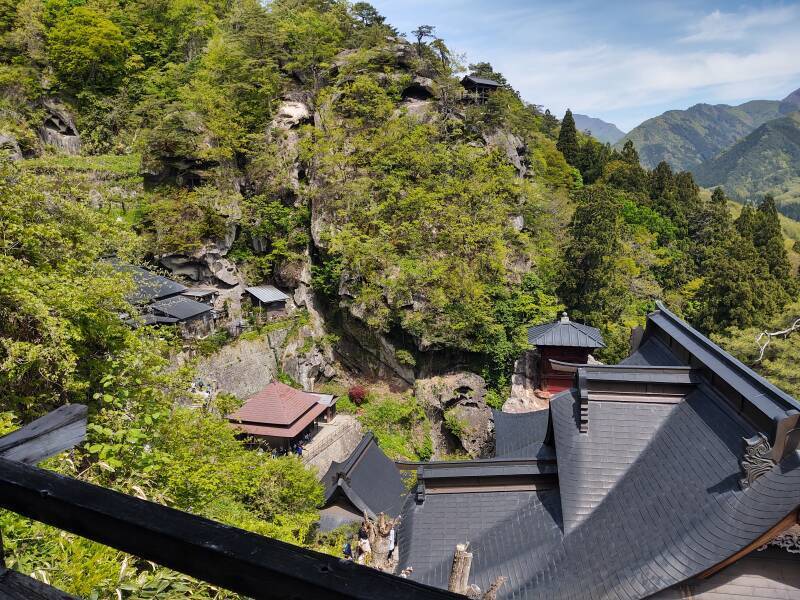
Yes, I was there. It is open on three sides and very well ventilated, but several people were masked so I put mine on. This was in early May of 2023, when mask usage was much more common than in the U.S. but still well below 100%. I tried to pay attention and do what the majority of people were doing, or else put my mask on just in case.

You look down over Yamadera town and realize how high you have climbed. There's the rail line with the station a little right of center, and the river running left to right.

Turning toward your right or the southwest, the valley opens out into the open basin a few kilometers west of Yamadera. The city of Yamagata is to the southwest, roughly straight ahead but hidden by the mountains in the below picture.
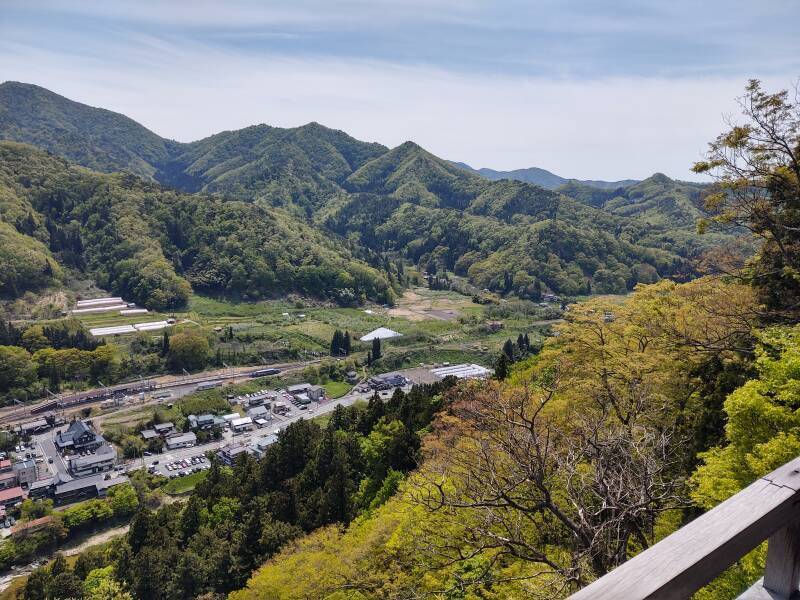
And now an east-bound train from Yamagata to Sendai is pulling into Yamadera Station.
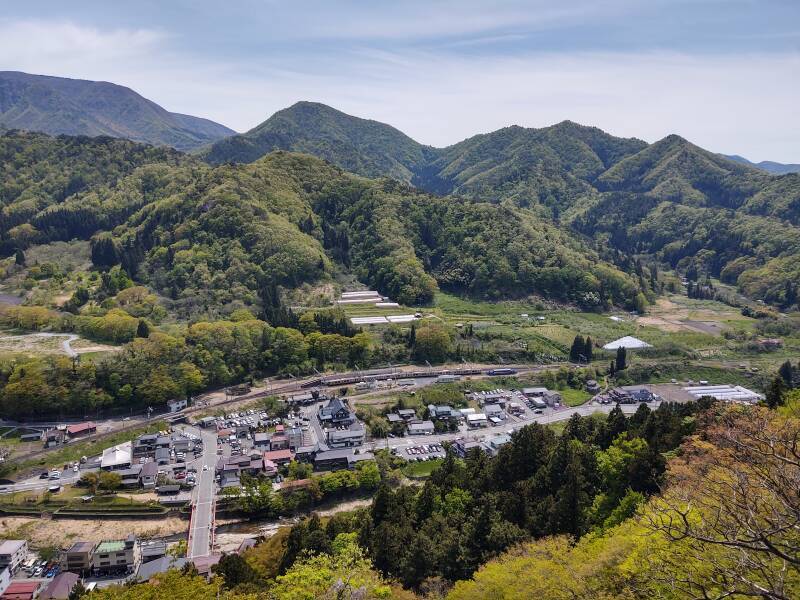
Back Down to Town
It's time to descend back down one thousand steps.
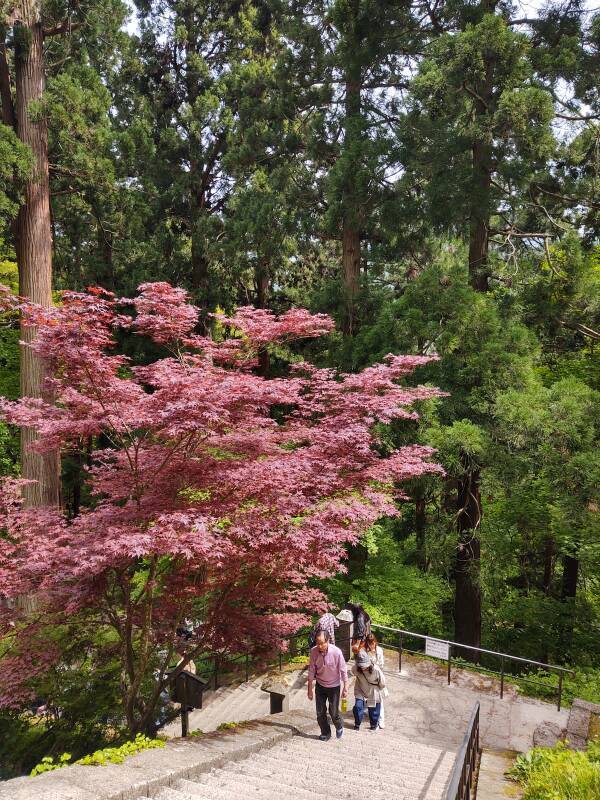
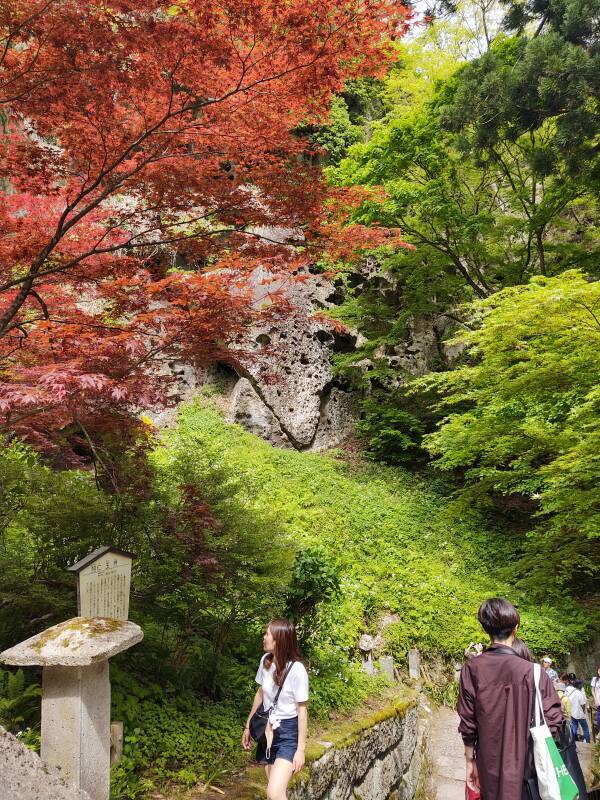
The temple complex became a prefectural park in 1950. It became quite popular as Japan recovered from World War II. So, the government built a giant wooden slide! You could hike to the top and then slide back down. Imagine the speed you could build up with the 160 meter elevation drop!
Unfortunately, the frequent injuries led to it being dismantled in the early 1970s. I would have signed a waiver and jumped on it.

Since there's no longer a moderately dangerous wooden slide, you can get your thrills by eating some balls of indigestible starch that can pose choking and bowel obstruction hazards if you aren't careful.
Several shops down in Yamadera town sell tama konnyaku, steamed balls of konnyaku. That's the common name of Amorphophallus konjac, a plant species native to Yunnan in China. Sometimes it's called "yam" but it's not really part of that plant family.
Its underground stem is edible, containing about 40% glucomannan gum. That's a water-soluble polysaccharide that is mostly indigestible fiber. Noodles made with konnyaku are called shirataki. The noodles are something like 97% water and 3% konnyaku, meaning that they are very low in digestable carbohydrates.
The standard tama konnyaku serving is a skewer with three steamed balls of about 2.5 cm diameter with a little hot mustard, all for ¥100.
Some poorly designed and hastily eaten konjac candies caused choking deaths among children and elderly people in the San Francisco Bay area, along with several cases of bowel obstruction. That led to U.S. Food and Drug Administration warnings in 2001. Chew thoroughly and drink plenty of water! And, konjac is fairly tasteless, so ask for extra mustard.
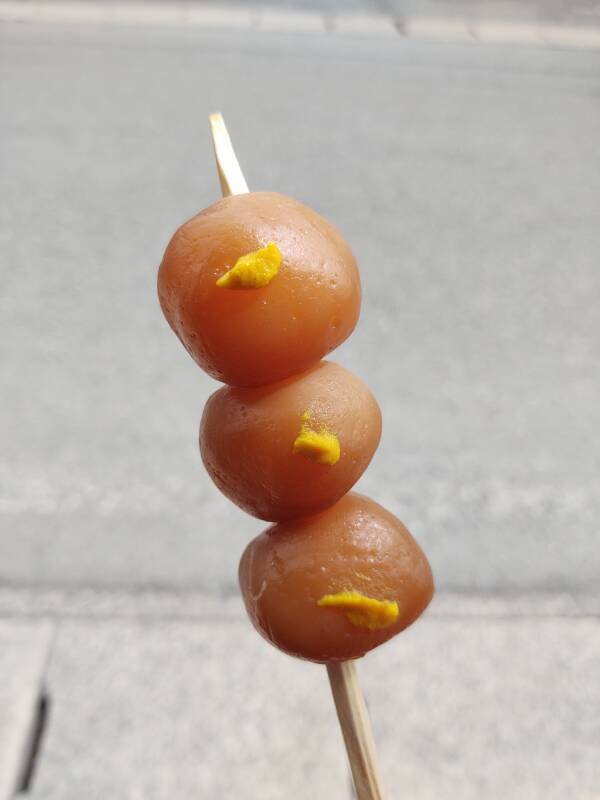
Returning to Yamagata
A train from Sendai to Yamagata is approaching the station. I would return here to spend another day, hiking the Minenoura trail past mountain forest temples and shrines.
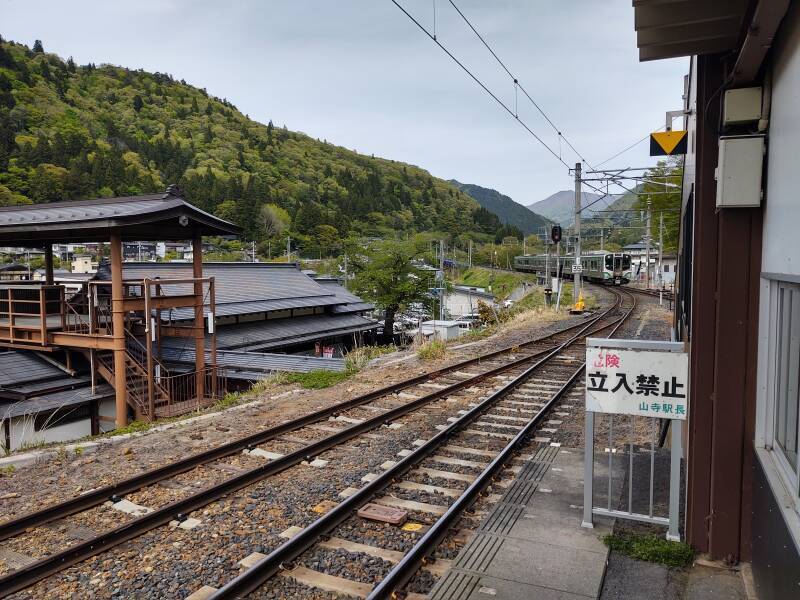
Back in Yamagata I had ramen with curry, black oil, and sesame.

Other topics in Japan:
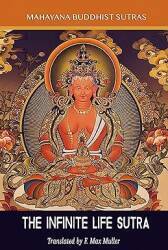
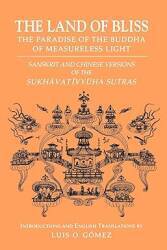
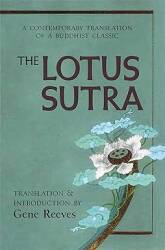




































Pareilolia, from παρά είδωλον, "beside-shape" or "instead-of shape", is the tendency to perceive a meaningful pattern within a vague stimulus, like human and animal faces and bodies in clouds, the Moon, burned toast, and rock faces.